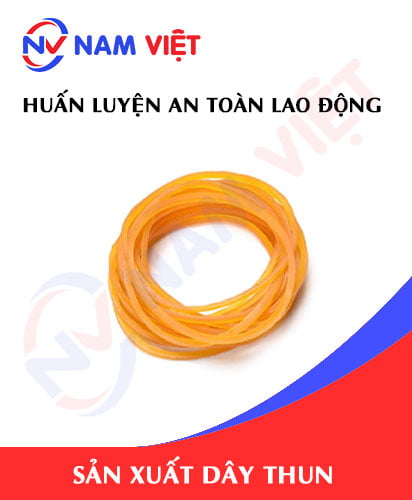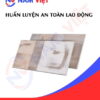Occupational safety training for elastic band manufacturing
99,000 ₫
Note: The above price is calculated per person, the price may fluctuate depending on the number of learners participating in the course and the market movement, for more accurate price support please refer to the pricing table or contact our consultants directly.
Occupational safety is an important issue in factories manufacturing elastic bands and needs to be addressed promptly to ensure the health and safety of workers, enhancing the reputation of businesses. The Safety training course is one of the effective solutions to raise awareness about how to prevent occupational accidents for workers involved in manufacturing elastic bands.
Table of Contents
Toggle1. Overview of Elastic Bands
a. What is an elastic band?
- An elastic band is a type of flexible cord made from rubber fibers or other materials such as plastic, polyurethane, nylon, polyester… Elastic bands are often highly elastic and quickly rebound when stretched. They are widely used in the production of clothing, footwear, medical devices, handbags, safety belts, garments, toys and many other applications.
- According to statistics from the General Statistics Office of Vietnam, the output of elastic band production in 2020 reached approximately 131,000 tons, a 3.3% increase compared to 2019. In 2020, Vietnam’s elastic band exports reached 460 million USD, a decrease of 10.7% compared to 2019, ranking second among exported textile and garment products, accounting for 11.3% of the total textile and garment export turnover.

b. Types of machinery for elastic band production
The types of machinery and equipment for elastic band production include:
- Elastic band rolling machine: this machine is used to create elastic bands from materials such as rubber, nylon, polyester, etc. The machine can be configured with different dies to create different types of elastic bands in terms of thickness and size.
- Elastic band knotting machine: this machine is used to create knots for elastic bands. The machine can be configured to create different types of knots in terms of size and shape.
- Elastic band cutting machine: this machine is used to cut elastic bands into different lengths and remove unwanted knots.
- Elastic band pressing machine: this machine is used to press elastic bands together or to press elastic bands onto other materials such as fabric or paper.
- Elastic band printing machine: this machine is used to print images or information on elastic bands.
These types of machinery are often used in elastic band production factories to create various elastic band products to serve the needs of consumers and other industries.

c. Representative elastic band manufacturing companies in Vietnam
Some representative elastic band manufacturing companies in Vietnam include:
- Hong Phu Elastic Band Co., Ltd.
- Hoa Phat Elastic Band Co., Ltd.
- Quang Phong Elastic Band Co., Ltd.
- Pacific Elastic Band Co., Ltd.
- Thien Phuc Elastic Band Co., Ltd.
- Vinatex Elastic Band Co., Ltd.
- Xuan Phong Production and Trading Co., Ltd.
These companies have been and are producing elastic band products with diverse sizes, qualities, and uses.
d. Specific jobs in an elastic band production factory
Group 1
- Executive director, deputy executive director, and department manager in an elastic band production factory.
Group 2
- Safety officer: manages safety in the factory, designs safety procedures, supervises and urges employees to comply with safe work procedures.
Group 3
- Material selection: Choose suitable raw materials for elastic band production such as rubber, nylon fibers, polyester, elastic,…
- Material processing: Raw materials are processed before being put into the production machine, such as cutting into small fibers, peeling off the outer layer,…
- Cleaning: Processed materials need to be cleaned before being put into production.
- Production: Raw materials are put into the elastic band production machine, undergoing a process of processing and recreation to create elastic bands with a corresponding elasticity, durability and stretch.
- Elastic band cutting: After production is complete, the elastic threads will be cut according to the required size and length.
- Quality control: Elastic bands after production must go through a quality control process before being packaged and delivered.
- Packaging and delivery: Elastic bands are packaged using appropriate packaging methods, then delivered to customers.
Group 4
- Office jobs, serving, sales, marketing.
- Production management, quality management, human resource management, material management, financial accounting management.
- Research and development of new products, designing product packaging and models.

2. Overview of occupational safety training course for elastic band production
Within the scope of this article, we focus on issues related to group 3, because group 3 is the group that directly participates in the production process, bearing the highest risk of occupational safety. Refer to other groups here
a. What is group 3 occupational safety training?
- Occupational safety training for group 3 consists of training sessions to equip workers with the knowledge of how to prevent occupational accidents.
- The occupational safety training course will help workers recognize and prevent dangers, and limit the risks of occupational accidents at work.
REGISTER FOR OCCUPATIONAL SAFETY TRAINING SERVICES
b. Training time
First-time safety training time
- The total training time is at least 24 hours, including the test time.
- 8 hours of theoretical study on the system of policies and laws on occupational safety and hygiene
- 8 hours of theoretical study on basic knowledge of occupational safety and hygiene
- 4 hours of theoretical study on specialized training content
- 2 hours of practical study on specialized training content
- 2 hours of theoretical test at the end of the training course
The safety training center will divide the time into many training sessions depending on the time arrangement for employees. But usually, there will be 6 training sessions, the course will last for 3 days, provided that the manufacturing company can arrange continuous study time.
Periodic safety training time
- Before the occupational safety card expires, if the employee wants to be re-issued, they must undergo a periodic occupational safety training course, with the periodic safety training time being at least 50% of the first-time safety training time.
Explanation: the total periodic occupational safety training time is at least 12 hours, including the test time. After completing the periodic training course and passing the required test, the employee will be re-issued or have their occupational safety card renewed.
c. Content of the training course
| No. | TRAINING CONTENT | TRAINING TIME (HOURS) | |||
| Total | Of which | ||||
| Theory | Practice | Test | |||
| I | System of policies and laws on occupational safety and hygiene | 8 | 8 | 0 | 0 |
| 1 | Overview of the system of legal documents on occupational safety and hygiene. | 6 | 6 | ||
| 2 | System of standards and technical regulations on occupational safety and hygiene. | 1 | 1 | ||
| 3 | Specific regulations of state management agencies on occupational safety and hygiene when newly constructing, expanding or renovating works, facilities for the production, use, storage, and inspection of machinery, equipment, materials, and substances with strict requirements on occupational safety and hygiene. | 1 | 1 | ||
| II | Basic knowledge of occupational safety and hygiene | 8 | 8 | 0 | 0 |
| 1 | Basic knowledge of dangerous and harmful factors at the workplace. | 4 | 4 | ||
| 2 | Methods for improving working conditions. | 1 | 1 | ||
| 3 | Safety culture in production and business. | 1 | 1 | ||
| 4 | Rights and obligations of employers and employees; policies and regimes on occupational safety and hygiene for employees; functions and duties of the occupational safety and hygiene network. | 1 | 1 | ||
| 5 | Occupational safety and hygiene regulations, safety signs, safety instructions and the use of safety equipment, personal protective equipment; professional skills for first aid in occupational accidents, prevention of occupational diseases. | 1 | 1 | ||
| III | Specialized training content | 6 | 4 | 2 | 0 |
| General knowledge about types of machinery, equipment, and substances that generate dangerous and harmful factors; analysis, assessment, management of occupational safety and hygiene risks, and safe working procedures with machinery, equipment, and substances with strict requirements on occupational safety and hygiene. | 6 | 4 | 2 | ||
| IV | Safety training test at the end of the training course | 2 | 2 | 0 | 0 |
| Total | 24 | 22 | 2 | ||
See more training content for 6 groups
d. Occupational safety card
After completing the occupational safety training course and passing the test, the employee will be issued an occupational safety card (also commonly referred to as a group 3 occupational safety certificate).
The group 3 safety card will clearly show information such as: full name, date of birth, specific job and work environment. It will also include the training time, a red stamp, and a signature confirming the completion of the training course.
According to the regulations on issuing safety cards specified in clause 2 article 24 of Decree 44/2016/ND-CP, there are two cases:
- In the case that the employer and the employee have a labor contract, the employer must sign, stamp and affix a seal on the safety card for the trained person in group 3 after completing the training course from the occupational safety training unit and passing the test.
- In the case that the employee is a freelancer, seasonal worker, and does not have a labor contract, the training unit must sign, stamp and affix a seal on the safety card for the employee after completing the training course from the occupational safety training unit and passing the test.

3. Identifying dangers affecting workers during elastic band production
The dangers affecting workers during elastic band production may include:
- Risk of eye pain, dry eyes, and eye strain from constantly looking at heating lamps and elastic band production machinery.
- Risk of occupational accidents: Due to the use of machinery, equipment, production tools, as well as the operation of electrical, pneumatic, hydraulic, mechanical, heavy load and high-pressure systems during the production process.
- Risk of depression, stress, and tension: Due to high work pressure, long working hours, and repetitive work for a long period of time.
- Risk of respiratory diseases: Due to toxic gases, chemical dust, and bacteria in the air at the elastic band production factory.
- Risk of vision impairment: Due to having to stare intently at the product during the production process.
- Risk of burns or deformities: Due to contact with chemical products, raw materials, and elastic band production machinery.
- Risk of electric shock: Due to operating electrical equipment during the production process.
4. Types of occupational accidents that often occur to workers during elastic band production
Occupational accidents that often occur during the production of elastic bands include:
- Getting caught, squeezed, or tangled in machinery: Due to the close relationship between the machinery parts during elastic band production, not wearing protective clothing or not complying with safety procedures when operating machinery can lead to the danger of getting caught, squeezed, or tangled in the machinery.
- Getting hit or punctured: When using cutting or joining tools for elastic bands, collisions or punctures from other hard objects can occur.
- Fire and explosion: Due to the use of chemicals, toxic gases or the use of electrically operated machinery, the risk of fire and explosion during elastic band production is very high.
- Scratches and cuts: During the production of elastic bands, cutting and joining tools can cause scratches and cuts if not wearing enough protective equipment.
5. Safety measures when participating in elastic band production
Safety measures when participating in elastic band production include:
- Use of protective equipment: Employees must be provided with adequate protective equipment, including masks, gloves, protective glasses and steel-toed boots to protect them from chemicals, dust and accidents during the production process.
- Professional training: Employees must be trained in safety procedures and regulations, how to use protective equipment and prevent accidents during the production process.
- Use of safe machinery: Production machinery needs to be checked periodically to ensure they operate safely and effectively.
- Adjusting production procedures: Production procedures need to be adjusted to ensure the safety of employees. For example, elastic band production needs to use safe chemicals, minimize exposure to toxic chemicals, and establish separate areas to store chemicals.
- Regular safety inspections: Regular safety inspections need to be performed to ensure that safety measures are being implemented effectively and that risks are detected and resolved in a timely manner.
- Limiting exposure to harmful substances: Employees need to limit their exposure to harmful substances, including chemicals and dust. There needs to be protective equipment to minimize employees’ exposure to these harmful substances.
- Safe classification, packaging and transportation of products: Products need to be classified, packaged and transported correctly to ensure the safety of consumers and employees during transportation.
- Regularly organize work environment monitoring in factories and enterprises, collect and analyze harmful factors to workers, thereby adjusting to reduce the level of danger to prevent occupational diseases for them.

6. Benefits of occupational safety training for elastic band production
An Toan Nam Viet provides businesses with great benefits after completing occupational safety training courses according to the regulations in Decree 44/2016/ND – CP on occupational safety and hygiene, for companies, factories, and enterprises.
- Employees can recognize the potential risks of occupational accidents and take preventive measures to avoid occupational accidents.
- Businesses can establish risk prevention measures in production, operation, and maintenance procedures.
- Reduce costs when occupational safety risks occur.
- Uninterrupted production process will help increase labor productivity and product quality.
- Comply with occupational safety laws, avoiding legal risks.
- Create prestige and professionalism in all aspects, thereby enhancing the brand for your business.
Nam Viet’s training courses are the solution to prevent and combat external factors affecting each individual so that they can avoid dangers that can lead to injury or, more seriously, death.
REGISTER FOR OCCUPATIONAL SAFETY TRAINING SERVICES
7. Customer feedback after completing the occupational safety training course for elastic band production
An Toan Nam Viet has many years of experience in the mission of accompanying many businesses in Vietnam in general and in the southern provinces in particular. And that responsibility is something very precious to Nam Viet, which is why Nam Viet’s Occupational Safety Training has always been focused on becoming more and more professional. The motivation for An Toan Nam Viet to grow strongly to this day comes from the positive and constructive feedback from businesses. Below is the feedback from our partners that we have served.
Bac Nam E&C Investment and Construction Joint Stock Company
“The first time I used the service at An Toan Nam Viet, I was very surprised by the enthusiastic 24/7 support of the team of consultants. The class organization was very quick and convenient for our company, thank you very much for Nam Viet’s service!”
Hoa Dat Construction and Trading Joint Stock Company
“Nam Viet’s service has helped us a lot in simplifying occupational safety and completing safety records for our work process. The team of consultants is enthusiastic and timely in answering our questions. 5 stars for Nam Viet”
See more customer interviews after using An Toan Nam Viet’s service
8. An Toan Nam Viet’s capacity for occupational safety training
An Toan Nam Viet is a reputable and quality occupational safety training center in Vietnam today. With occupational safety training sessions continuously taking place at production workshops, factories or construction sites across the country (all 63 provinces and cities in Vietnam).
REGISTER FOR OCCUPATIONAL SAFETY TRAINING SERVICES
Occupational safety training license
- An Toan Nam Viet has been inspected by the Safety Department of the Ministry of Labor – Invalids and Social Affairs and granted a certificate of eligibility to operate occupational safety and hygiene training. This further strengthens our capacity for occupational safety training.

Materials and lectures
- Before the occupational safety training materials are put into the occupational safety training courses, they are reviewed and censored to ensure that the lectures are accurate in terms of knowledge and effective when applied.
- The teaching method of the lecturers is synchronized according to the teaching standards of An Toan Nam Viet, which is a method that experts in occupational safety and hygiene training have researched and drawn from the teaching process to bring the highest knowledge acquisition efficiency to students.
Facilities
- Controlling the factors in the classroom that affect the training process will increase the teaching performance and the knowledge acquisition efficiency of students.
- Our training course support facilities always arrange spacious classrooms that meet standards for area, lighting, training equipment… etc.
9. Reputable and quality national safety training center
At An Toan Nam Viet, we always prioritize our professional dedication to occupational safety training. For us, imparting knowledge to workers on how to protect themselves so that they can have a safe journey on their path to making a living is a contribution to nation-building.
To ensure the effectiveness of the training, we prepare carefully and meticulously every little detail. From preparing tools, equipment, teaching devices to textbooks, documents, sound, and lighting.
Our occupational safety training lecturers are experts with many years of experience in the field. They even have research projects to identify dangers in all occupations and how to prevent them.
The lecturers’ lectures are drawn from reality and delivered in a vivid and easy-to-imagine way for workers. These factors help workers feel comfortable during their study time and acquire the knowledge we teach well. Of course, the knowledge imparted is always closely aligned with Decree 44/2016/ND-CP.
From there, they can grasp many measures to prevent dangers and how to protect themselves. At the same time, they can apply it in the most suitable way in their actual work.
Our safety training center is proud to be a reputable and professional provider of occupational safety training services with the following advantages:
- Competitive training costs but training quality is still guaranteed.
- Flexible training schedule based on the production situation of the company.
- Fast and legally compliant procedures for issuing occupational safety training certificates.
- Lecturers are people with many years of experience in the profession.
- The classroom environment is controlled to increase teaching performance and knowledge acquisition efficiency for students.
- The lectures are compiled to be suitable for occupational safety work at businesses.
- An Toan Nam Viet works with dedication and professionalism to support customers accurately and quickly.

10. Refer to more occupational safety training materials for elastic band production
- Occupational safety materials for elastic band production
- Set of occupational safety training materials
- Set of occupational safety training test questions
- Multiple-choice test for occupational safety in elastic band production
- Slides for the lecture on occupational safety training for elastic band production
1 review for Occupational safety training for elastic band manufacturing
No comments yet















namchinh.haiphong341
Dịch vụ lắm nhé! tôi rất hài lòng với cách làm việc của trung tâm